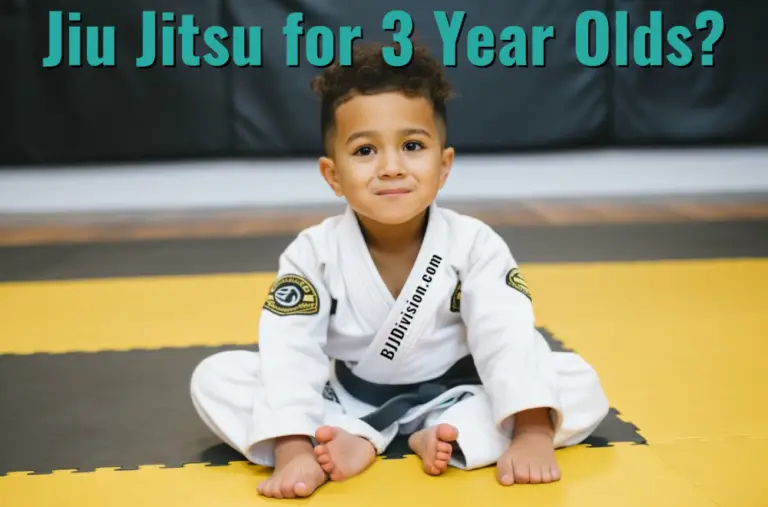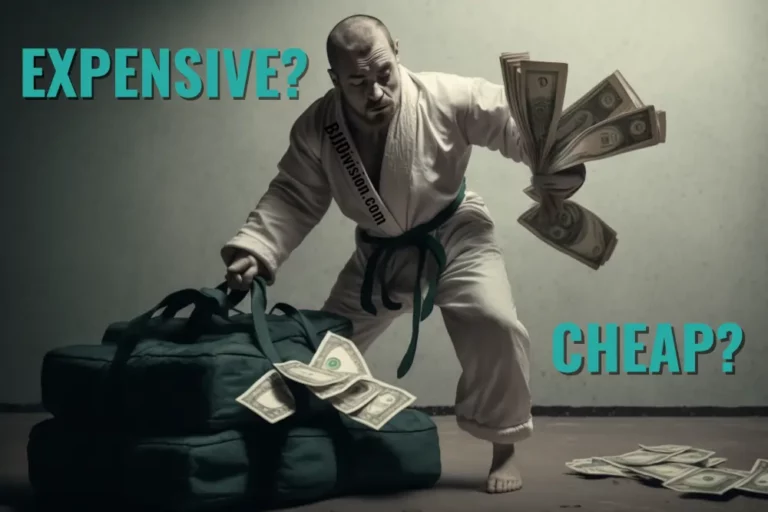Jiu Jitsu vs Judo: Who would win in a Fight? Complete Comparison
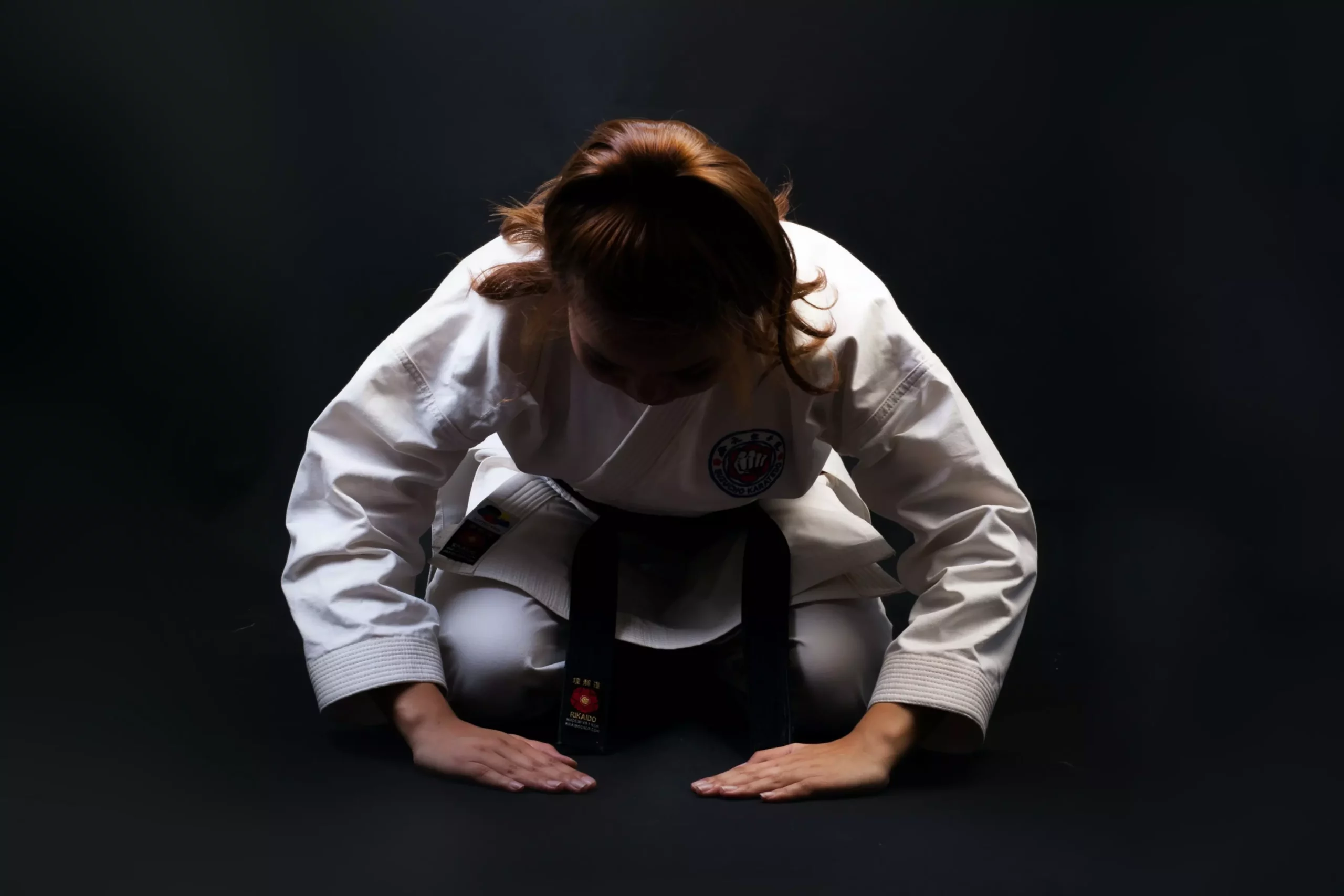
Jiu Jitsu vs Judo: Both are martial arts and combat sports, and both are grappling sports. Judo focuses mainly on stand-up fighting while Jiu Jitsu focuses more on ground fighting. Additionally, Judo is always done wearing a Gi. Jiu Jitsu on the other hand has developed a No-Gi branch over the years where fights take place without a Gi, making it No-Gi Jiu Jitsu.
Both sports have many similarities because Brazilian Jiu Jitsu originated from Judo. In 1914 Mitsuyo Maeda left Japan and came to Brazil where he passed on his Judo knowledge to Carlos Gracie and his brothers. The Gracie brothers, especially Helio Gracie, then adopted and refined the art making them the root of what is known as Brazilian Jiu Jitsu today.
Let’s see how far the two arts moved apart from each other and which one might be better in certain circumstances. Here’s what we will cover:
The Differences and Similarities

As stated above, Brazilian Jiu Jitsu originated from Judo but focused on different aspects and developed in another direction than Judo over the years. Today there are many differences between the two martial arts.
Jiu Jitsu vs Judo: Differences
Clothing
Judo is always done in a Gi which is usually white. Jiu Jitsu allows many Gi colors and also has a No-Gi Jiu Jitsu branch, where rashguards and shorts are worn.
Positions
Judo focuses mainly on stand-up fighting, while Jiu Jitsu focuses on ground fighting.
Judo Rules
Judo fights can either be won by “Ippon” (full point) which is an immediate win or by “Waza-ari” (half points) if 2 of those are scored. A win by “Ippon” or full point is awarded if:
- The opponent is thrown to their back
- The opponent is submitted
- The opponent is held down for 20 seconds
Half points can be won by:
- Throwing opponent, but he is not completely landing on his back
- Holding opponent down for at least 10 seconds but less than 20 seconds
If a Judo fight goes to the ground, the competitor on top is given a maximum time of 30 seconds to submit his opponent, usually much shorter, depending on how much progress is made. Jiu Jitsu takes place mostly on the ground, it only starts standing.
Judo is tighter regulated than BJJ. For instance, in Judo grips on the legs are not allowed when standing. This eliminates most wrestling techniques and is not the case in Jiu jitsu. Many techniques that are usable in Jiu Jitsu incur penalties in Judo.
Brazilian Jiu-Jitsu rules
The ultimate goal in Jiu Jitsu is to submit the opponent resulting in an immediate win. If none of the competitors is able to submit the opponent, the match is decided by points and advantages.
In BJJ points are earned for progressing positions. The exact number of points given for each advancement is specific to the ruleset of the competition and differs between Gi and No-Gi fighting. For example, most rulesets award 2 points for scoring a takedown and 2 points for establishing a dominant position. Subsequent advancements in position often award even more points, illustrating the focus on ground fighting.
If a BJJ fight goes to the ground, it stays there unless one of the competitors manages to get up or the fight is stalling. Therefore “Pulling Guard” is a valid technique in Jiu Jitsu, where one of the competitors pulls his opponent into his guard while falling to the ground. A variety of positions and submissions is allowed in Jiu Jitsu leading to a complex fight on the ground.
Submission-only rulesets are getting more popular, where no points or advantages are awarded at all.
Techniques
Judo focuses on throws to gain dominant positions and score points in competition. Control, balance, and rapid attacks using the momentum of the opponent are the most important concepts of Judo. These concepts are mainly enforced through grips on the Gi, footwork and momentum changes. BJJ focuses on control on the ground and advancing to more dominant positions which will eventually lead to submission holds like chokes, joint locks, and compressions.
In the following video Travis Stevens, an Olympic Judo medalist and Jiu Jitsu Black Belt, shares his view on the differences between Judo and Jiu Jitsu:
Jiu Jitsu vs Judo: Similarities
Positions
Judo and Brazilian Jiu Jitsu fights start in a standing position.
Goal
Both sport aim to control and/or submit the opponent. Both were means to self-defense and aimed to enable the smaller and weaker individual to defend themselves against the bigger opponent by using superior angles and using their momentum against them.
Rules
Both sports have a point system under most rulesets. There are restrictions like gripping restrictions in both sports.
Techniques
There are many techniques and aspect that can be found in both sports. The armbar is a prime example. It aims to bend the arm “in the wrong direction” at the elbow and is very common in both sports.
Culture
Both sports emphasize on respect. Bowing after class is mandatory at most schools as well as shaking hands before and after fights to show mutual respect. Luckily this goes for most martial arts and their competitors today.
Quick comparison
The following table provides an overview on which martial art has an edge over the other concerning different aspects. Obviously both sports have a lot of positive aspects.
| BJJ | Judo | |
| Self Defense | x | x |
| Competition recognition | x | |
| Stand-up fighting | x | |
| Ground fighting | x | |
| Physical training | x | x |
| Mental training | x | x |
| MMA and real-life usage | x | |
| Popularity | x | x |
| Safety | x | x |
| Community | x | x |
| Cheaper Price | x |
Jiu Jitsu vs Judo: What would happen in a Real Fight or MMA fight?

As MMA (Mixed Martial Arts) fighting comes closest to a real fight where all techniques are allowed, we can analyze the realistic fighting capabilities of each martial art through its popularity and success in MMA.
BJJ
There is undeniable proof that BJJ works in MMA and real fights. However, it also has its drawbacks.
Check out the in-depth section on Jiu-Jitsu in MMA in our Jiu-Jitsu vs Wrestling article.
Judo
Judo is rarer in MMA, mainly because it is heavily dependent on grips in its original form. Nevertheless, many aspects of Judo can be incorporated in MMA fighting when making certain adaptions that account for the different rulesets and possibilities.
The most famous example for successful Judo techniques in MMA is Ronda Rousey. She went on a 12-0 winning spree after joining the UFC, winning 9 of 12 fights by submission. All of them were armbars and most of her wins were set up through Judo techniques. Judo can definitely be successful MMA.
In summary, both arts have their place, and both can be effective in real fights. Jiu Jitsu seems to be the winner though. It is vastly more popular in MMA and needs less adaption to work in real fights.
Jiu Jitsu vs Judo: Self Defense

Both sports are great for self-defense as both focus on controlling the opponent and establishing dominant positions.
In our opinion Jiu Jitsu is the winner when it comes to one-on-one self-defense situations and Judo wins in more dynamic fight situations and here’s why.
BJJ
The overwhelming success BJJ has had in MMA fights throughout the recent years is a testament to how well rounded it is.
At the risk of repeating ourselves, check out our article on Jiu Jitsu vs Wrestling, which includes an in-depth section on how BJJ performs in a real fight.
Judo
Judo is often criticized for depending on the Gi when it comes to self-defense situations. Because who wears a Gi in day-to-day life? Right, nobody. But this point is not as strong as it seems at first sight. Usually, people wear jackets. Although jackets are not as robust as Gi’s and might not be able to survive a throw, a good Judoka will be able to use grips on his opponents clothing to control him and can even control his opponent without grips on clothing, which is the bread and butter of self-defense.
In a dynamic fighting scenario, where several aggressors might become involved in the fight, Judo is extremely versatile, provides great control and preserves the ability to disengage at all times. It also provides the ability to take an opponent out quickly and move on. This makes Judo superior to BJJ in many real-life fighting situations.
Here are a few words from Joe Rogan on which martial art is best for self-defense:
Ranking Systems in BJJ and Judo

BJJ
The image below shows the IBJJF’s (International Brazilian Jiu-Jitsu Federation) Graduation System, which includes all of Jiu Jitsu’s belt ranks: white, blue, purple, brown, and black, as well as the Coral Belt and Red Belt.
The overview shows the belt progression, promotion times, and minimum ages for each belt.
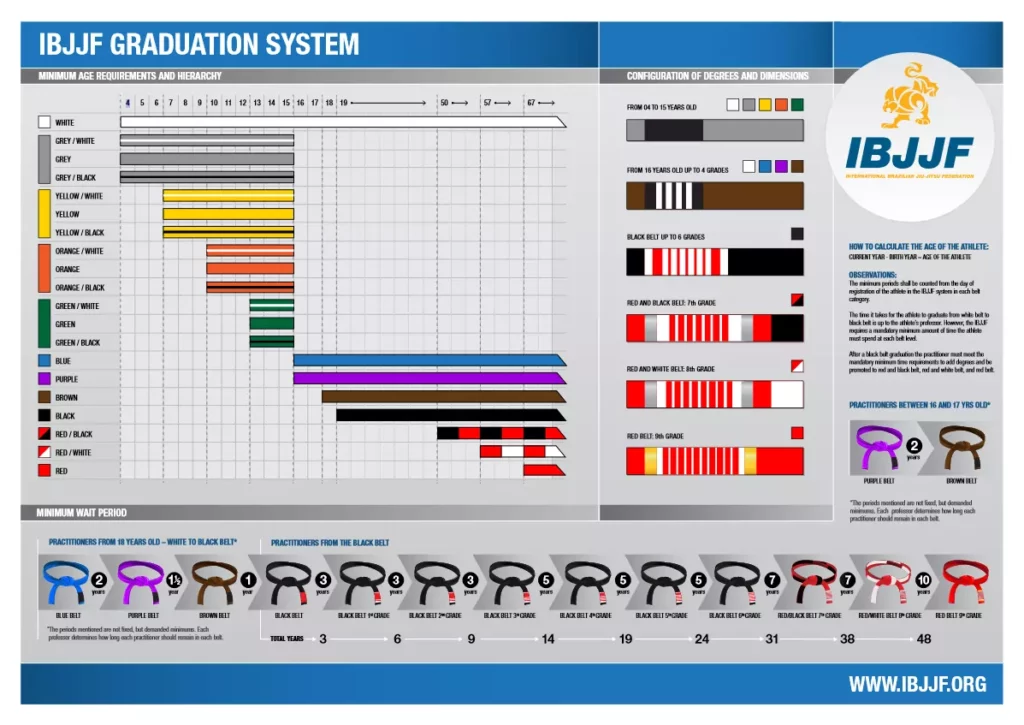
Judo
The Judo belt ranking system varies between countries. For example, in the United States the USJA (United States Judo Association) determines the ranking system. In general, the senior ranking system roughly looks like the following image suggests. The system distinguishes between Kyu Grades and Dan Grades, starting at Black Belt. There are no stripes earned, but they belt progression is generally faster. A black belt is usually achieved after about 5 years by consistent practitioners.
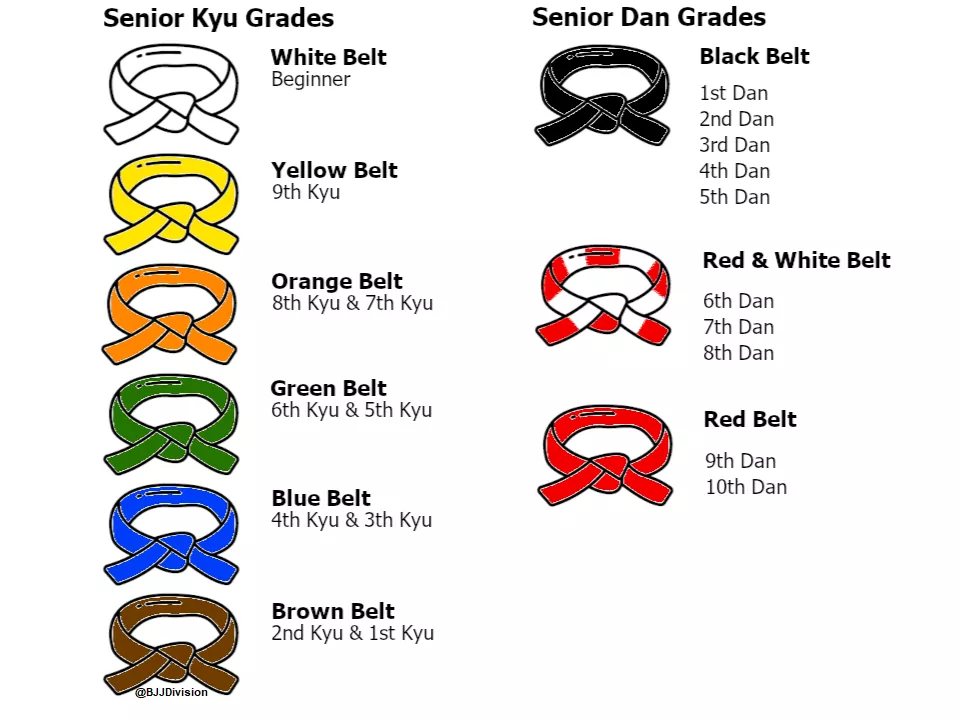
Jiu Jitsu vs Judo: Competition

BJJ
BJJ competitions are held under varying rulesets as many popular promotions and federations make up for the competitive Jiu Jitsu scene.
Unfortunately, Jiu Jitsu is not an Olympic sport for now. If you want more information on why BJJ isn’t Olympic, check out our detailed article on the topic.
Judo
Judo became an Olympic Sport in 1964 at the Olympic Games in Tokyo and has been one ever since. Judokas all around the world strive to make it to the Olympics, represent their nation and prove themselves on the biggest competitive stage. There mostly one ruleset used all over the world.
Culture

Both martial arts have the same origin but developed in different directions.
Originally both were only meant to be used for self-defense purposes. However, Brazilian Jiu-Jitsu quickly developed to an offensive martial art in the early 20th century.
Judo’s usage was more limited to formal fighting throughout the years but has also, although more sporadically, found its way to modern fighting formats. Nevertheless, both arts are still geared towards self-defense today.
Judo is the more formal martial art today. It requires a practitioner to always wear the formal outfit, the Gi, and formal procedures like lining up by rank and bowing to show respect are mandatory. These formalities are also found in many traditional Jiu Jitsu schools but are less likely to be found in modern, MMA-related schools.
Popularity

Jiu Jitsu and Judo don’t enjoy the popularity around the world.
Judo is a long- and well-established sport by now being an Olympic Sport for more than 50 years. Jiu Jitsu is still growing in popularity and has not reached its peak yet.
Google Trends confirm exactly this. Jiu Jitsu is constantly growing in popularity while Judo is falling in popularity, making both sports equally popular worldwide today. For example, BJJ is popular in the USA, where is has surpassed Judo in popularity many years ago.
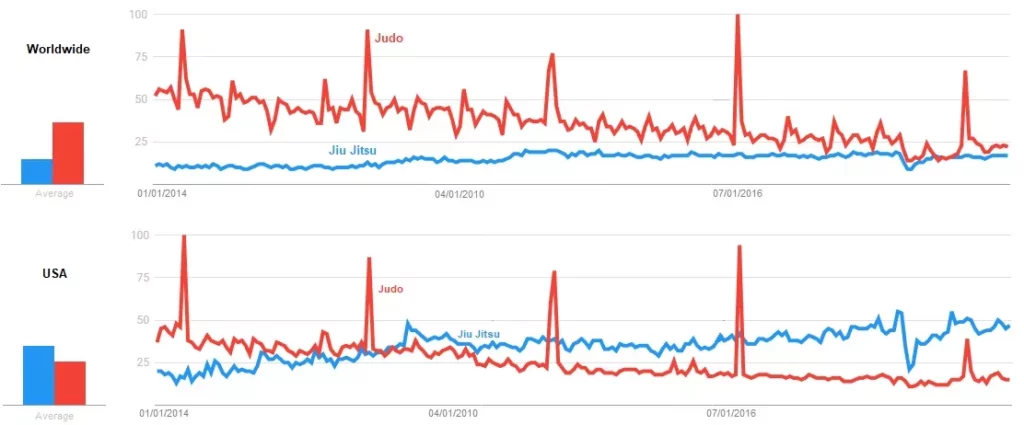
The increasing popularity of Jiu Jitsu is caused by its prevalence in MMA fighting and public figures promoting it based on their own positive experiences.
Injuries in BJJ and Judo

Since both sports are full-contact combat sports, there is an inherent risk of injury that cannot be completely eliminated. Almost everyone that trains one of the two sport for long enough has been injured. Nevertheless, there are ways to minimize the risk of injury.
Rib and clavicle injuries as well as joint injuries are very common in both sports. For example, Judo and Jiu Jitsu practitioners that fight in a Gi will agree that both sports are tough on the finger. That’s why you see most competitors competing with taped up fingers.
For a detailed look at the injury statistics in Jiu Jitsu you should check out our articles How common are Injuries in BJJ?, analyzing most studies on BJJ injuries available, and How to prevent and treat Neck Pain and injuries in BJJ.
For Judo, a study from 2019 which reviewed Judo competition matches over a period of 21 years, found that traumatic injuries occurred in 1.1% of competitive matches. This rate is fairly equal to the injury rate found in competitive Jiu Jitsu fights. Obviously, minor injuries and training injuries happen more often.
Cauliflower Ear
Cauliflower ear is common in Brazilian Jiu Jitsu as well as Judo. Check our Jiu Jitsu vs Judo article where we talked about causes treatment and prevention of cauliflower ear.
Conclusion
Always be open to learning from other martial arts, as there is not one best martial art.
Jiu Jitsu is more open concerning rulesets than Judo. It is also a well-rounded martial art, providing a good foundation for MMA and self-defense, while Judo is more restricted and specialized in stand-up fighting.
Because Judo and Jiu Jitsu have the same origin and many similarities, many athletes transitions between the sports or incorporate aspects of the other sport into their fighting arsenal.
If you are curious how Jiu Jitsu compares to other martial arts, check out or articles on:



